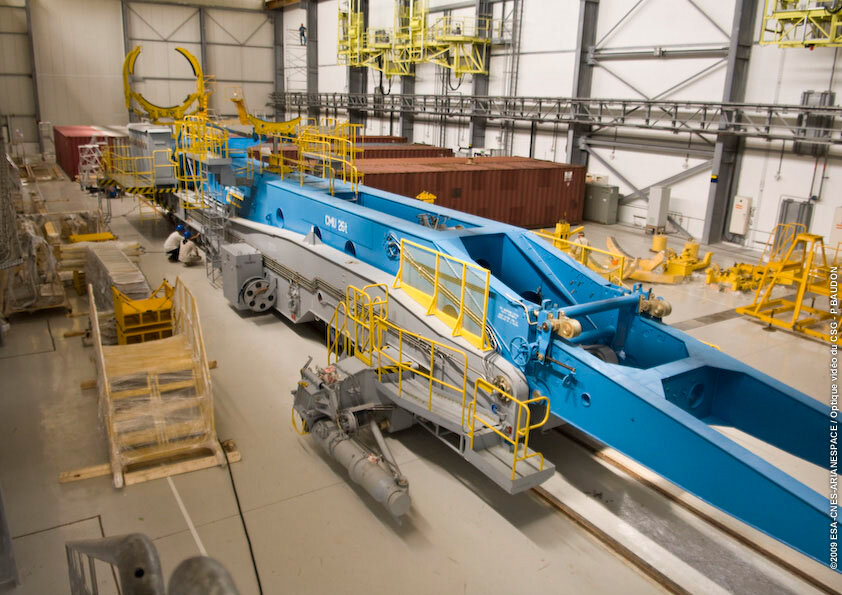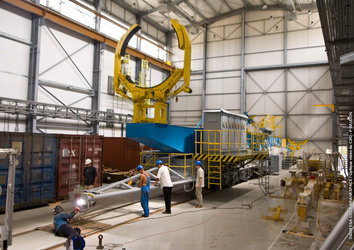Building the Soyuz launch facility at Europe’s Spaceport
Activity is continuing at the Guiana Space Centre (Centre Spatial Guyanais – CSG), Europe’s Spaceport in French Guiana, as the Soyuz launch site takes shape. Soyuz is a medium-class launcher and its performance will perfectly complement that of the other ESA launchers, Ariane and Vega.
On the spaceport’s new launch pad, the infrastructure that maintains Soyuz in its erected position prior to launch is being completed. In the nearby launcher assembly and testing building (монтажно-испытательный корпус; montazhno-ispytatelniy korpus – MIK), ground support equipment for Soyuz integration is being prepared.
This new launch facility for the venerable Soyuz vehicle is located 12 kilometres northwest of the existing Ariane 5 launch complex, extending the spaceport’s operational zone further up the French Guiana coastline.
Horizontal rollout

The horizontal transfer of Soyuz launchers at Europe’s Spaceport in French Guiana will follow the same basic procedures used for Soyuz operations at Baikonur Cosmodrome. The image shows the rollout of the Soyuz FG launcher and Soyuz
Soyuz launch system approaches completion

Wide-angle view of the almost-complete Soyuz launch system. The four primary support arms are shown in their closed position. Directly behind the two rear support arms is the set of umbilical masts that will service the Soyuz Block A core stage, its Block I third stage, the Fregat upper stage and the payload. Visible below in the launch table’s 15-metre diameter circular opening are four triangular guides that will be connected to the four strap-on boosters – providing stability for the suspended vehicle until liftoff. The two other arms extending into the opening carry electrical umbilicals for the Soyuz boosters and the Block A core stage.
Soyuz launch table opening

The erected Soyuz will be positioned inside this
Soyuz ‘service cabin’

A platform known as the Soyuz ‘service cabin’ is located beneath the upper level of the launch table. Here, it is shown in the retracted position, which moves the cabin free of the circular opening for the final countdown, engine ignition and liftoff. The service cabin contains ground support equipment and provides access to the launcher’s lower portion.
Launch pad viewed from the flame pit

The four-level reinforced concrete structure that serves as the Soyuz launch pad – viewed from the far side of the flame pit. The configuration shown here is the same as used on the other Soyuz launch facilities at Baikonur Cosmodrome in Kazakhstan and Russia’s Plesetsk Cosmodrome. A difference with the installation at CSG will be the addition of a mobile gantry, which will be employed for payload integration with the Soyuz erected in its vertical position.
Lightning protection towers

The Soyuz launch pad is surrounded by four lightning protection towers, which are a feature of all the pads at CSG. The picture also shows the Soyuz launch system in the ‘ready’ position – with the four support arms closed and the two umbilical masts raised to service the medium-lift vehicle. A recently added element is the facility’s system of floodlights, which are installed on four masts positioned around the launch pad.
Umbilical masts on the launch pad

The two umbilical masts on the Soyuz launch pad, shown in the raised position. The shorter, blue-coloured mast is for the Soyuz vehicle’s Block A core stage. It is straddled by the larger mast, which provides fluids and electrical connections for the launcher’s Block I third stage, the Fregat upper stage and the payload.
Transporter/erector system

The rail-mounted transporter/erector system inside the MIK. The Soyuz launch vehicle is integrated and transferred to the launch pad in the horizontal position. At the pad, the erector raises the Soyuz into the upright position.

The transporter/erector system for Soyuz inside the MIK. Once the Soyuz launch vehicle’s integration is completed in a horizontal position inside the MIK, the launcher is lifted onto the transporter/erector by two overhead cranes (one of which is partially visible in the upper background).
continue to part two of the article




